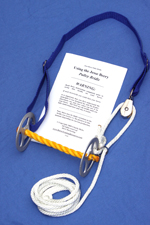In Today’s Horse Tips Magazine Issue:
“Is Your Horse Misinterpreting What You’re Asking?”
It happened years ago on the TV show
“60 Minutes”, and it was quite shocking.
The journalist Mike Wallace got
himself in a pickle.
He was interviewing the Soviet President
Boris Yeltsin.
Wallace asked the former president if
he was “thin-skinned” about the press.
But the translator mis-translated the
question.
When Yeltsin heard the question, it
was translated to him as:
“Is Boris Yeltsin a
thick-skinned hippopotamus?”
Can you imagine???
Yeltsin responded by saying that Wallace
should express himself in a more civilized manner.
Funny how things can get miscommunicated.
And when it comes to horses, it happens
all the time.
Think about it.
Your horse doesn’t know what you mean
when you ask him to do something unless he’s
done it enough to know what you want.
When you first ask a horse to do something,
he’s more or less “guessing” what you want.
He’s actually searching for a way out
of the pressure you’re putting on him.
And when the pressure’s off he kind of
goes “whew!” and realizes when you do “X” then
he’s supposed to do “Y”.
The wrong thing to do would be to quit
the pressure when he’s not doing what you want.
That would teach him to do something you didn’t
ask.
You’d be surprised how often that happens.
An example is riding a horse and you ask
him to go left.
But he goes right.
If you let him when you were asking him
go left, then you just taught him to either do
what he wants and/or to go right when you want
to go left.
Thus, you might ask yourself if you’re
having trouble getting your horse to do something.
Is it because you’re not “translating” it
correctly?
But that’s not the whole picture.
There’s also the part that it takes
about 30 days for a horse to learn a verbal cue.
So just because a horse just learned what
“trot” meant doesn’t mean that from here on out he’s
going to trot when you say trot.
It has to be reinforced constantly.
Not reinforcing it is not translating to
his language.
One of the best ways you can translate to
your horse is to have a good foundation on him.
The foundation starts from day one of
any horse’s training.
In fact, most trainers I know will fix
a horse problem by starting them over as if
they didn’t know anything.
Why?
Because they need to see what he knows
and what he doesn’t.
And what he doesn’t know will have to
be taught to the horse.
Or, maybe he learned the wrong thing due
to a mis-translation.
Thus, if your horse has behavioral problems
and you can’t seem to fix it, then I would urge
you to restart him and go through the motions and
fix it.
Diana Quintana has a great program
she puts her horses through and I would
encourage you to follow it.
Here’s a for instance from her program.
When you work a horse in the round pen
and you’re getting him going from one gait to
the next, it should be smooth.
Not just “JERK!” into the next gait.
No.
It should be more of a smooth transition.
That means from going slow to going faster
and from going fast and going back down to slower.
A horse needs to know he can go from fast
to slower and do so without being excited and out
of sorts.
You must “translate” to him that that’s
what he must do.
As I said, Diana’s system is tried, tested,
and very thorough.
To see more about it, click on the following:
http://horsetrainingresources.com/dvd-dianaq.html
Remember.
A horse may not be doing something right
because it’s what he understood to be right.
Boris Yeltsin understood Mike Wallace said
he was a thick-skinned hippopatamus.
But that’s not what Wallace said.
It got lost in translation.
Is your horse not doing something right be-
cause it gets lost in translation?
http://horsetrainingresources.com/dvd-dianaq.html
OK – that’s it for today. Stay safe around your horses!
Charlie
More notes from our readers:
=================================================================
“I’m new to your e-mails. Reviving my love & passion of
equitation and the relationship of horses and the enlightened
insights of horsemanship with your e-mails are a treasure.
And yes, by and by, everyone of us should get an appropriate
video from Horse Training Resources.
Thanks, Jodee”
——–
“Thank you for sharing this with us…. I am now getting
my grandchildren exposed to the wonderful world of horses
and donkeys. I enjoy your emails and tips so much…
Keep ’em coming!
——–
“THANKS Charlie! By the way, just wanted you to know how
much I appreciate you little “tidbits” of information and
insight. Also, really appreciate your relationship with God
and how it is apparent at your site.
Have a blessed night, Karen”
———
“Just had to let you know I first became aware of Professor
Berry’s school of horsemanship books as a young farm girl
during the 1950’s. The books were offered in a farm magazine
called the Prairie Farmer. I saved my money and purchased
them at that time. Believed in them at that time and have
not altered my opinion. I am still training horses and still
use the knowledge gained from them. Sandy”
===================================================================
*********************************************************************
Discover the most successful horse training course ever created.
“Prof. Jesse Beery’s Illustrated Course in Horse Training”
8 Volumes of pure, effective horse training wisdom used
by thousands around the world. Printed in one, easy-to-use,
spiral-bound manual.
http://horsetrainingresources.com/beery.html
**********************************************************************


